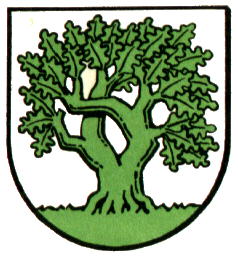Unterböhringen: Difference between revisions
Jump to navigation
Jump to search
Knorrepoes (talk | contribs) m (Text replacement - "/Arms of " to "/Arms (crest) of ") |
Knorrepoes (talk | contribs) m (Text replacement - "{{media}}" to " {{de1}} {{media1}}") |
||
| Line 24: | Line 24: | ||
No old seals or arms of the village are known. The arms of Unterböhringen were devised in 1931 and show the large oak tree on the Tälesberg in the municipality. The oak tree was a longtime symbol for justice. It took, however, until 1959 for the final approval by the State. | No old seals or arms of the village are known. The arms of Unterböhringen were devised in 1931 and show the large oak tree on the Tälesberg in the municipality. The oak tree was a longtime symbol for justice. It took, however, until 1959 for the final approval by the State. | ||
{{ | |||
{{de1}} | |||
{{media1}} | |||
[[Civic Heraldry Literature - Germany|'''Literature''']]: Gönner and Bardua, 1966 | [[Civic Heraldry Literature - Germany|'''Literature''']]: Gönner and Bardua, 1966 | ||
Revision as of 11:48, 26 December 2022
This page is part of the German heraldry portal |
Heraldry of the World |
|
German heraldry:
|
Selected collector's items from Germany:
|
UNTERBÖHRINGEN
Province/State : Baden-Württemberg
District (Kreis) : Göppingen
Incorporated into : 1974 Bad Überkingen
| German | In Silber auf grünem Boden eine grüne Eiche. |
| English | No blazon/translation known. Please click here to send your (heraldic !) blazon or translation |
Origin/meaning
The arms were officially granted on September 14, 1959.
No old seals or arms of the village are known. The arms of Unterböhringen were devised in 1931 and show the large oak tree on the Tälesberg in the municipality. The oak tree was a longtime symbol for justice. It took, however, until 1959 for the final approval by the State.
Literature: Gönner and Bardua, 1966


